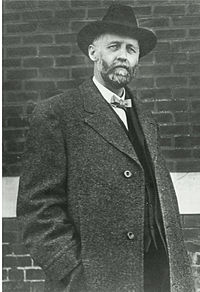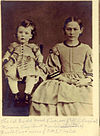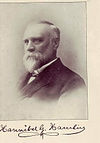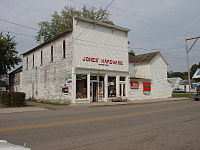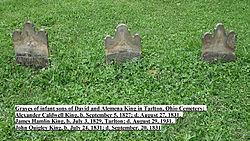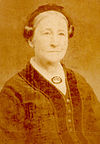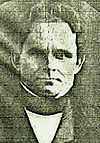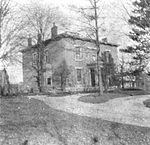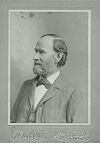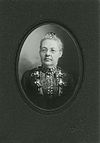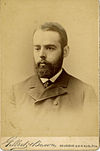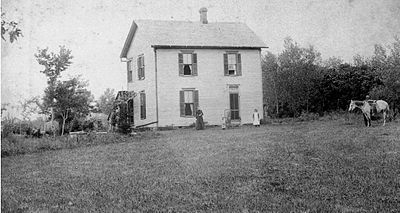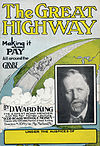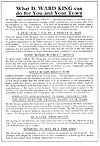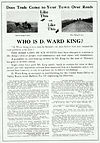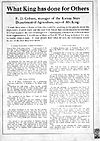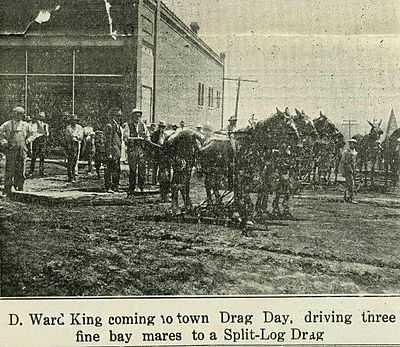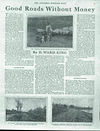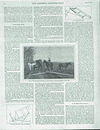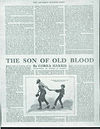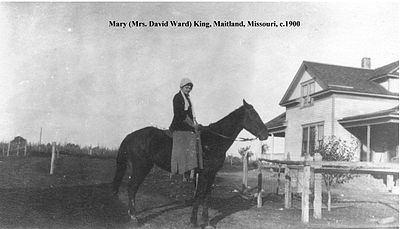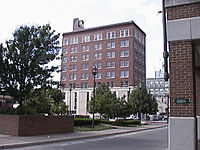- David Ward King
-
David Ward King (October 27, 1857 – February 9, 1920), a farmer who lived near Maitland, Missouri, was the inventor of the King road drag. His invention, which was the horse-drawn forerunner of the modern road grader, had great influence on American life because his invention improved the widespread dirt roads of his day to the extent that they could accommodate the advent of the automobile, rural mail delivery and mail order catalogues.
Contents
Family and early life
David Ward King was often referred to then and now as "the Missouri farmer", which he was. However, he was born, reared and educated in Springfield, Ohio, and came from a very prominent and wealthy family of that city.
David Ward King was the grandson of his namesake, Springfield merchant and real estate developer David King. His paternal grandfather, David King, was probably born in Baltimore, Maryland in 1796. His paternal grandmother, Almena Caldwell King, was born in Hillsborough, New Hampshire on August 16, 1809. However, she moved with her parents when she was young to early Portsmouth, Ohio, which is in southernmost Ohio at the confluence of the Scioto River and the Ohio River, where her father established a successful carpentry business. Both of Ward's paternal grandparents had been orphans. Ward's grandfather, David King, was found as a toddler wandering the streets of Baltimore during a yellow fever epidemic in which both his parents presumably died. David knew only his own name and could tell nothing about his parents. He was found in a Baltimore hotel and taken in by a Robert Quigley who had a farm near Shippensburg, Pennsylvania and who had "wagoned" to Baltimore for supplies.[1] While Robert Quigley did rear and educate David King on his Cumberland County, Pennsylvania farm, he did not adopt him, which is why David's last name stayed King. The Quigleys were devout members of the nearby Middle Spring Presbyterian Church. David King grew up, regularly attending that church, which began a strong tradition of religious correctness in the King family that beyond question made its way down to Ward.[2]
Upon attaining adulthood, Ward's grandfather David King obtained an apprenticeship as a store clerk in Portsmouth, Ohio, where he met Ward's grandmother, then-teenage Almena Caldwell. However, her older brother and father fell from a small boat and drowned in the nearby Scioto River. Soon thereafter, Almena's mother died of grief. Her Uncle Hannibal Gilman Hamlin (first cousin to Lincoln's first Vice President, Hannibal Hamlin) became the guardian of her and her brother, Hamlin Caldwell, moved them to Cincinnati and saw to their education. David King married her there when she was seventeen.[3]
After their marriage, David and Almena soon moved to Tarlton, Ohio, where David put his store clerking experience to good use by opening a general store. Tarlton was on Zane's Trace, which at the time started at the Ohio River across from Wheeling, West Virginia, and passed through Zanesville, Lancaster, the intermittent state capital of Chillicothe and ended at the Ohio River in their previous home town of Portsmouth. The store prospered and David starting investing in real estate, which built their wealth substantially over their years in Tarlton.
All did not go well for David and Almena, however. As David often did, he took his wagon "across the mountains" to Baltimore to get supplies for his store—a trip that would take him a month every time he did it. While he was away for his trip in the late summer of 1831, he left Almena in Tarlton with their infant children, as he always had until then. Tragically, their three young sons, Alexander Caldwell King, born September 5, 1827, James Hamlin King, born July 3, 1829 and John Quigley King, born July 24, 1831 all died of smallpox within weeks of each other on August 27, August 28 and September 20, 1831.[4] Almena had to deal with this catastrophe alone.
Ward's father, Robert Quigley King, who was born on August 13, 1832 in Tarlton, was their first child to survive. Understandably, Almena insisted on going along with David on his supply trips after that, carrying with her the infant Robert Quigley King as a babe in arms. Their next child was Samuel Noble King, who was born in Tarlton on October 22, 1834. He went all his life by his middle name of "Noble". The Kings named him after their country neighbor, Samuel Noble, who had come from Emmitsburg, Maryland to become one of the first settlers of Tarlton and who had a large farm just south of Tarlton.[5] Ward's mother, Mary Elizabeth King, was born to David and Almena in Tarlton on April 1, 1837, and David King, Jr., later to become a Civil War colonel, was born in Tarlton on September 11, 1839.
Historical Marker for Route of Zane's Trace, Tarlton, Ohio
As time passed, Tarlton began to lose some of its importance. The state capital was moved from nearby Chillicothe (its last location outside Columbus) to Columbus, Ohio in 1816, and the National Road (present U.S. Route 40 or more roughly Interstate 70) went through the center of Ohio. This road started at Baltimore and eventually wound its way across the entire country to end up in San Francisco, California. So, the focus of commerce in Ohio shifted from the communities along Zane's Trace to the center of the state. Among the cities the National Road crossed was Springfield, Ohio, where it arrived in 1836 and stopped for ten years while lawmakers argued about where it would go from there. Located at that terminus, Springfield especially boomed during those ten years.
Several of Robert Quigley's grandchildren, the Rodgers families, had moved to Springfield. David's childhood companions were Robert Quigley's Rodgers grandchildren instead of Robert's children. Robert Quigley probably took in David King out of "empty nest syndrome", since his own children were grown and likely out on their own at the time he found David. According to the Quigley Family History, Robert Quigley's second daughter Jennet "Jane" Quigley married James Rodgers, her Cumberland County, Pennsylvania, neighbor, and continued to live near the Robert Quigley farm. So, it was Robert Quigley's grandchildren, Richard Rodgers, Mary Rodgers, Rachel Rodgers, Dr. Robert Rogers and William Rodgers who lived close to the Quigley farm during David's childhood. They would have been the children with whom David King grew up and with whom he would have been particularly close. Their daughter Mary Rodgers married a Cumberland County neighbor, Isaac Ward. Their daughter Rachel Rodgers never married. Their son, Dr. Robert Rodgers, married Effie Harrison, daughter of a Pennsylvania Militia brigadier general. Their son William Rodgers married the sister of Effie Sarah Harrison. All of these Quigley grandchildren, their spouses and families, apparently except Eleanor, moved to Springfield, Ohio in 1831 (source in footnote says 1833). Modern day Littleton & Rue Funeral Home now occupies the Rodgers mansion at 830 North Limestone Street, Springfield, Ohio.[6]
Likely on their urging, David and Almena King moved to Springfield as well in 1840. David, a very astute businessman, who was already very well off, proceeded to build a significant portion of early downtown Springfield, which was known for long thereafter as "King's Row".[7] Their daughter, Sarah Jane King, was born to them in Springfield on December 20, 1841. Their daughter Almena Caldwell King was also born there on February 1, 1848. Unfortunately, David King died on August 8, 1849 in a cholera epidemic, which he contracted while caring for other victims of the outbreak.[8]
After her husband's death, Almena frugally held on to the family wealth. She built a large home at 2 Ferncliff Place in Springfield in about 1852, which was long known as the King Homestead. The Springfield City Directory of that time located it simply as "North of Buck Creek." Buck Creek, which is probably wide enough to be called a river at that point, has long marked the north boundary of downtown Springfield. There are tall limestone cliffs on both sides of it. Isaac Ward cut building stone from these cliffs, at the location of present-day Cliff Park in Springfield, that later became part of many of the early buildings in Springfield.[9] There was only the Limestone Street footbridge across Buck Creek at the time Almena King built the King Homestead, and that footbridge was more than a block upstream.[10] She bought this land from Robert Quigley's grandson-in-law, Isaac Ward, who lived across the street on present-day Fountain (then Market). The Isaac Ward Mansion still stands today and is still occupied. The Kings and the Quigley descendants remained very close, which is why Ward's father gave him the middle name of "Ward", and Ward went by that middle name all his life. One family account credits Isaac Ward with having been particularly helpful to the King family after the death of David King.[11] Isaac Ward also sold a large tract of his land to Wittenberg College, which now forms the eastern part of its campus and is the reason the main road through present day Wittenberg University is Ward Street.[12] The King Homestead was out in the country when first built, which was to get her boys away from the reported 122 saloons near their home in Springfield proper.[13] All three of her sons attended nearby Wittenberg College.[14]
Almena Caldwell King died of diabetes on May 30, 1878, from which she had suffered greatly for a long time before it finally claimed her. Her son-in-law, famous Lutheran minister and later Wittenberg professor Luther Alexander Gotwald, happened to drop in while passing through Springfield on a train and was able to greatly comfort her during her last hours. The King Homestead stayed in the King family for a long time after Almena's death. However, eventually it was sold to Chi Omega Sorority of Wittenberg University and is today its sorority house.
After Almena's death, Rev. Gotwald wrote a loving biography of David and Almena in which he penned this moving tribute to his late father in law.
He was a most devoted husband, a firm and yet a most affectionate father, and eminently, honorable and successful, a consistent and faithful Christian, a trustee of the First Presbyterian Church, and an intelligent, genial, liberal, talented and noble man in all things. You are indebted largely to him for most of your temporal blessings which you enjoy, for without his industry, economy and business success, your lot in life would be entirely different. Revere therefore, his memory. Ever think of him gratefully and affectionately, often visit his grave in the cemetery at Springfield, Ohio. And always seek to imitate his character and life, thus showing yourselves worthy descendants of such an estimable ancestor.[15]Of all the descendants of the first David King, his creative and industrious grandson, David Ward King undoubtedly did the most to live up to the spirit and the letter of Rev. Gotwald's heartfelt counsel.
David Ward King was born on October 27, 1857 in Springfield, Ohio. His father was real estate developer, investor and Springfield Fire Chief, Robert Quigley King.[16] His mother was Harriet Danforth King. As mentioned, Robert Quigley King, was born in Tarlton, Ohio, and was the first child of Almena and David King to survive.
Robert Quigley King came to a largely undeveloped Springfield at age nine in 1840, with his sister, Mary Elizabeth, age three and his brother, David Jr. age one. He attended the early Springfield schools. He later recalled hunting for squirrels in a woods that later became the train station (now demolished) and what would be close to the location of the present Clark County Library. His father died when he was eighteen. Nonetheless, his mother was able to send him and, as they arrived at college age, his brothers to Wittenberg College. At one time, she had them all in college at the same time—and Almena could afford that. When Robert Quigley King first started at Wittenberg, it held classes in the lecture room of the First Lutheran Church. However, while he was a student, Wittenberg moved to what is now the western part of its present-day campus. He was in the first class to graduate from Wittenberg. The history of early Springfield mentions how much he liked to hunt, especially in the woods that later became today's Snyder Park, which would have been just down Buck Creek from his childhood home at the King Homestead.[17]
Robert Q. King married Miss Harriet A. Danforth at New Albany, Indiana on January 15, 1857. To them were born five children: David Ward King on October 27, 1857; Dr. Thomas Danforth King, who was born on July 20, 1859 and who died December 23, 1889; Robert Leffler King, who was born on August 24, 1863; Almena Adaline King (Warrick), who was born on September 17, 1869; and Margaret "Madge" Caldwell King, who was born on February 13, 1873 and who died when she was fourteen years old on December 30, 1886. Ward's ill-fated brother, Dr. Thomas Danforth King, was a graduate of Princeton and a practicing physician in Springfield. He took his name from his direct ancestor, Thomas Danforth, who was Lieutenant Governor of Massachusetts, a founder of Harvard College, a judge at the Salem witch trials and on whose estate the city of Framingham, Massachusetts is situated today. Framingham has a museum named after him.[18] There was a Thomas Danforth in every generation after that, until Dr. Thomas Danforth King, who died before he married his fiancée and had children. He died a slow and painful death from cancer of the eye, in his parents' home with his fiancée at his side.[19] His death left David Ward King and Robert Leffler King as the surviving sons of Robert Quigley and Harriet King. Ward's sister, Almena Adaline King, married industrialist Harvey Warrick in Springfield, Ohio. She died December 18, 1941 in Cleveland, and he died on April 21, 1942.
As Almena's oldest child, Robert Quigley King soon became involved in helping his mother manage the family's real estate holdings in Springfield. He had several retail businesses in Springfield, but his primary activity seems to have been real estate development. The family built the King Building on what was then Market Street and later became Fountain Street, just north of High Street. The King Building became the headquarters for the temperance movement in Springfield and also the location for Bumgardner Studio, where many of the photos of the people who lived in Springfield in the late 19th century were taken. He subdivided land on present-day North Wittenberg Avenue, just south of Wittenberg University, into the "Robert Quigley King Second Addition to the City of Springfield, Ohio." He built his own home at 642 North Wittenberg Avenue. He later moved to live in an apartment in the King Building, allowing his son Robert Leffler King to occupy it. Upon his death, he left the house to his daughter Almena King Warrick and her husband Harvey Warrick.
Robert Quigley King served as Fire Chief for Springfield from 1879 until 1891. His obituary and the History of the Springfield Fire Department both credit him with being Springfield's second Fire Chief. However, the Fire Department History goes on to point out that several others before him performed that function, but did not carry the title. In those days, Fire Chief was an elected position. It is mentioned both in his obituary and in King family tradition that during a fire at the "whip factory", he was on a roof that collapsed, dumping him into the midst of the flames. However, the other firemen immediately poured their hoses on him, saving his life.[20] He was pulled from the fire, badly injured, but alive.[21]
Maitland, Missouri farmer
David Ward King often went by his middle name of "Ward", and he wrote it as "D. Ward King". His education was obtained in the Springfield, Ohio public schools and in Wittenberg College (now Wittenberg University) in Springfield. On December 29, 1880 he married Mary Willie (often spelled "Wylie") Burbank of Danville, Kentucky in Springfield. Mary was born in Danville, Kentucky on September 23, 1859. Mary was the daughter of Austin Milton and Lettitia (Reed) Burbank. He moved from Springfield, Ohio to this Maitland, Missouri farm as a recently married young man and began farming there. While living on that farm, he invented the King Road Drag (very famous in its day), which made country roads passable in wet weather and is still credited with making possible reliable rural mail delivery and the practicality of the automobile.
Probably as early as 1877 or 1878, his father, Robert Quigley King, obtained some 1,597 acres (646 ha) near Maitland in Holt County, Missouri. Family stories hold that his father received this land as the only asset of value owned by a person who owed him a lot of money as the only available way to obtain payment of that debt. After obtaining this farm in that way, his father retained it, even though this acquired farm was in far-off Missouri. When his father had acquired this farm and decided to keep it, he had to do something with it. Ward was his answer. So, Robert Quigley sent his son Ward to this farm in the spring of 1879 to begin farming it. During that summer Ward helped to thresh grain. However, Ward and Mary apparently did not actually move there until January 1881.
There is reason to believe that Ward's move to this farm was not completely voluntary, since, for generations back, there had been no farmers in his family. Years later, Robert Quigley King acquired another large tract of what was this time raw farm land in much closer Hancock County, Ohio, near the small village of Vanlue. In 1887, he sent his other surviving son, Robert Leffler King (who also went by his middle name, "Leffler"), off to develop that land and farm it. Leffler arrived at this land without buildings in the "thick of winter". There is no doubt that Leffler did not want to leave the ease of the family wealth in Springfield for a hard farm life. However, family members who knew him say he could not stand up to his father. So, he went, erected a house and farm buildings and otherwise developed the farm, overcoming many obstacles. He met and married his wife, Lola Montez Askam King, in the Vanlue community and brought up his family on this farm, which he called "Grassland Farm". He describes his many hardships in his farm journal, which hardships were probably very similar to the ones Ward must have experienced in turning himself into a farmer on his Maitland farm.[22]
Logic suggests that Ward's fate was destined to be much the same. However, in Ward's case, his invention enabled him to turn his fate to his immense advantage. Family members state that the fact that the travels associated with the promotion of his invention took him away from the farm a lot was not something city-bred Ward considered to be disagreeable. In fact, his son David Bryant King had pretty much taken over operation of the farm by the time he reached eighteen.[23] Leffler, after many years on his Hancock County farm, was finally able to move back to Springfield to help his father manage the family's considerable real estate holdings during his father's declining years. Like his brother, his son Edwin Askam King pretty much took over the operation of Grassland Farm.[24] Although separated by distance, the brothers always remained very close, and they constantly worked together on the family's real estate undertakings in Springfield.[25] Ironically, in the remarkably parallel lives of these two Springfield-reared farmers, their children were more farm people than they were.
In what was the King family tradition, David Ward was an implacable warrior against alcoholic beverages and the saloons that sold them. Leffler King's wife, Lola Montez King, proudly mentioned in her autobiography that they attended a temperance convention during their honeymoon.[26]
For his part, David Ward King organized the Prohibition Party in Missouri. He often spoke in district school houses on the topic. In Holt County, Mrs. King often went him on his crusades to ban the use of alcoholic drinks. Many were violently against prohibition and, as a result, against David Ward King as well. One time, at Eureka school house, someone went so far as to lodge a fence board between the spokes of the two rear wheels of the Kings' buggy so it would hit Ward in the head when he started out. As a result, he had to carefully inspect his buggy, before starting home after these temperance meetings. David Ward left the party later, because he felt prohibition alone was not enough for their platform, but he remained a staunch prohibitionist all his life.
The Kings were early members of the Maitland M.E., church and their two older children attended this church with them. The Kings and Lettie "Reed" King, their oldest daughter, became charter members of the First Presbyterian Church of Maitland. The Kings heavily involved themselves in civic and church affairs. He sat as one of the first trustees of Maitland's First Presbyterian Church and taught in the "Sabbath School".
David Ward King was a progressive farmer. He actively sought improved methods of farming. He constantly took measures to prevent washes and soil depletion on his land. He established some of the first bluegrass pastures in his township. He was a life member of the Holt County Farm Bureau.
In cooperation with Mr. J.R. Collision, Professor J.C. Crosen, Dr. Ira Williams and others, David Ward King was instrumental in bringing a Lyceum Course (a group of men who met for regular lectures and debates on topics of interest) to Maitland. He later became a life member of the Lyceum Association. The King home was often the headquarters for visiting clergy and for Lyceum entertainers.[27]
Invention of the King Road Drag
It was in 1896 that D. Ward King first dragged the road with an old frost-bitten pump stock and an oak post. The improvement in the dirt roads it worked was dramatic. Until then, the only way to firm up dirt roads had been to dump layers of stone on them and then press it in with a heavy roller to make a road surface resistant to turning into muck after every rain. This method was fairly effective, but it was also labor intensive and expensive. These stone-permeated roads were called "macadamized roads". These roads took their name from their Scotch inventor, John Loudon McAdam. Using his method, roads were covered with several layers of stone, starting with large ones and then reducing their size in each successive layer. The stones in the first level would be about the size of a human head. The stones in the next layer would be about the size of a fist. The final layer would be of stones of about the size of golf balls. It was grueling work to haul this heavy stone to the places needed, to unload it in the right places and then to spread it evenly over the road surface with only horse-drawn wagons and hand-held shovels and rakes. Further, in the days before powered stone crushers, there was the additional and very arduous task of smashing much bigger rocks down to the right size for use in the respective layers. This work came to be known as "making the big ones into the small ones." Men did it by hand by smashing large rocks with sledgehammers. In many states, convicts did this work and sometimes even built these macadamized roads by working on the roads themselves. When these convict crews worked directly on these roads, necessarily outside the walls of the prison, each man was typically chained to the next to prevent runaways. These convict road crews became the infamous "chain gangs" of that day. In the days of horse power, this method was just too time-consuming and expensive to be practical for widespread use.
The advantage of the King Road Drag was that it firmed up dirt roads by leaving a crown in the middle, which caused rain water to just run off, keeping the road dry and firm. Its crowning virtue was that, unlike pressing stone into the mud road surface, it was very quick and very inexpensive. The method quickly caught on. Draft horses, relieved of the need to drag farm wagons through mire, were able to haul a lot more farm produce to railroad sidings for transport by the railroad to distant markets. So, in 1903, Ward was employed by the Chicago and North Western Transportation Company to promote its "Good Roads Campaign." During 1904 and 1905 the railroad ran "Good Road" trains over their lines in Iowa. Ward rode these trains to instruct people along the lines on the construction and use of his invention. According to his promotional brochure, the railroad hauled him around in a "private car" and paid him a "handsome salary". His brochure, while not naming them, stated that "four important railroads" had done that. However, the enthusiasm of the railroad for improved roads quickly cooled when their ridership for short trips began to drop off dramatically. With improved local roads, people started travelling locally on their own bicycles (which were the craze of the day) and their own newly acquired automobiles. However, D. Ward King and his "Good Roads" program were already on their way, and the end of railroad support did little to stop it.
King Meetings
The "King drag movement [came] with a rush."[28] D. Ward King did patent his invention. However, its design was so simple that King did not enforce his patent rights.[29] However, he did make a good living by touring the country conducting and charging sponsoring organizations for "King Meetings" in which he explained to packed houses how to build and use his road drag. Wittenberg-educated Ward was, by all accounts, an eloquent speaker. His promotional brochure claimed that "An address on this subject is not, as you might suppose, dry and uninteresting. You will find that the novelty of the idea and its practical value will attract a larger attendance than a feature of mere entertainment."[30]
Over time, Ward conducted Good Roads campaigns in forty-six of the then-existing forty-eight states – all except Nevada and New Hampshire. He conducted them in Canada as well, including the province of Nova Scotia, where the King road drag was found better than any other method to work sandy roads, clay roads and rock roads.[31] One Canadian journalist was so impressed that he wrote and published this poem as his tribute to Ward.
MY FAVORITE KINGBy William Edward Park, Chatham (Canada) Daily News.
When knights were bold and ladies fair, and all that medieval junk.
And when for common folks like us the job of living was most punk.
When all the world was full of strife, and dangerous and that sort of thing.The cuss who most extinguished life was usually crowned king.But we in better days were born, when men in peace together live.
And kings are made to adorn a job that common people give.
And earn their living like the rest at banquets and that sort of thing.
Oh, nowadays it hardly pays to hold their lofty job of king.
But, there's another sort of king who still the crown of battle wears.
D. Ward's his name and he has fought for better thoroughfares.
That can be built without expense. He makes the very rafters ring.
With pleadings and arguments – and that is why his praise I sing.
For heaven knows we need good roads – good roads to let the farmer pass.
To market with his wheat and corn and sugar beets and garden sass.
And bring us closer to the farm and bring them closer to the town.
And D. Ward King, for what he's done, has pretty well earned a crown.—[32]David Ward King further widely publicized the process in a U.S. Department of Agriculture Farmers' Bulletin #321 in 1908 under the title The use of the split-log drag on earth roads[33] He also wrote articles explaining his drag, including one that appeared in the May 7, 1910 issue of The Saturday Evening Post titled "Good Roads Without Money." In 1904, the road drag and photos of its works were on display in the Agricultural Building at the Louisiana Purchase Exposition in St. Louis, Missouri. Many of these photos were taken in Clay Township. In 1910, Iowa dragged from Council Bluffs to Davenport and back in three hours. This was highlighted by the "Glidden Trail" scouts and became the River-to-River Road. During this time, Ward worked with Harry Crider, the Maitland postmaster, to post all his ever-growing mail and purchase all his ever-increasing need for boxes of stamped envelopes from the Maitland post office. This increased business made the Maitland post office eligible for its first rural route.[34]
Within ten years of his first speech, advocating the King system, the King method spread all over the country, Canada and worldwide. His writings were translated into Spanish, which allowed South American countries to benefit by it. The Philippines and Australia adopted it. Missouri spent two thousand of the dollars of the day to drag its main roads. Whole townships organized to drag every mile of road after every rain. One township in Iowa dragged its entire road system "completely" in three hours. In 1906, the state of Iowa amended its statutes to use the King system on the country roads. In 1909, Iowa made the law mandatory and even broadened it to include the unpaved streets of the cities and towns of that state.[35] His promotional brochure stated that "the road laws of six states have been changed to conform to Mr. King's ideas of proper road construction and road repair and maintenance."[36]
Some Iowa farmers even had a song they sung in his praise, as they did their road dragging, which went:
Dragging the roads, dragging the roadsDragging the roads with the King road drag;
Hard as a bone, smooth as a hone,
The roads that lead into Owasa.—[37]Family
Mrs. Mary Wylie King was active in women's organizations of the church. She worked for many years as an enthusiastic member of the Woman's Christian Temperance Union. She was an active member of Eastern Star, being chaplain of that order for many years. She did not like staying home while Ward travelled, a fact which she mentioned repeatedly in her letters to him. Even so, she did serve as his "manager" under one spelling of her maiden name of "M.B. Wylie". She served as the practice audience for his speeches. She edited and typed his letters, often serving as his "emergency secretary". Some called her the "Mother of Good Roads."[38] By all accounts, she was a very strong-willed woman, with a flair for the dramatic. Family members point to the photo she had taken of herself in "widow's weeds" as an example of her endearing way of dramatizing events—in that case, the recent death of her husband. She also never lost her staunch devotion to the cause of temperance, which the repeal of Prohibition did nothing to dampen. One family member reported that there was a time when she came upon another family member having a beer. After she finished telling him in no uncertain terms what she thought about that, the two of them remained thereafter permanently estranged. However, she and Ward, the great promoter of his world changing invention, were undoubtedly the perfect pair.
David Ward and Mary Wylie King had four children, who were all born in Maitland, Missouri. They were Lettie Reed King, who was born on December 29, 1881; Robert Quigley King, who was born on December 11, 1886; Miriam Danforth King, who was born on October 24, 1892; and David Bryant King, who was born on September 9, 1897.
Lettie Reed King went by her middle name of "Reed". She followed the King family tradition, which started with the original David King, of remaining a Presbyterian. In fact, she was a charter member of the Presbyterian Church of Maitland. She married Ralph Crider of Atchison, Kansas. After her father's death, she was the family member to whom all family members "took their problems." She also was a frequent source of information about her famous father.[38]
Robert Quigley King II served in World War I. He became an osteopath, graduating from the Kirksville School of Osteopathy. He practiced in Maitland, Missouri and Cushing, Oklahoma. His first wife, Margaret Isabel Moore, died on October 8, 1916. He then married Esther Harrison of Madison, Missouri and had four children with her. He died June 5, 1931 in Rosedale Gardens, Michigan. His wife Esther died on June 29, 1951.
David Bryant King took over the Maitland farm when he was eighteen and operated it for the rest of his life. He was always active in community affairs and was a member of Protective Credit Association and the Holt County Farm Bureau. He married Gladys Elizabeth McHenry of St. Joseph, Missouri. They had three sons. David Bryant King died on May 29, 1944 in a Maryville, Missouri hospital. After the death of her husband, his widow Gladys inherited her husband's interests in the family's real estate holdings in Springfield, Ohio and brought a legal action that forced the sale of those interests. Gladys died January 5, 1955 in an automobile accident.[39]
Miriam Danforth King married Ralph LeVerne Caywood, who was born in Maitland, Missouri on May 3, 1891. They had three children, who were all born in Maitland. She lived for many years in Coral Gables, Florida and did much to look after her mother in her mother's later years. Miriam died on March 28, 1957.
As was the case with Lettie Reed King, all of the Ward and Mary's children remained lifelong Presbyterians.
Affairs of David Ward King in Springfield, Ohio
Ward's mother, Harriet Adaline Danforth King, died on July 13, 1906 in Springfield, Ohio after a lingering illness. Ward's father, Robert Quigley King, died suddenly on November 26, 1917 in his apartments in the King Building in Springfield. The Springfield newspaper reported his death with a lengthy front page article that featured a large photo of him.
David Ward King and his brother, Robert Leffler King, inherited interests in their father's real estate holdings. Robert Quigley King had long owned the King Building, and there was a lot between it and High Street at the corner of Fountain and High in the very heart of downtown Springfield. At the time of his death, their father had begun building a new, very modern for its time, office building. Robert Quigley King's will left Ward and Leffler the King Building and this lot, subject to a one-third income interest in the profits from these properties to their sister Almena King Warrick for the rest of her life. He also left them some bonds in trust, which he instructed them to cash in and use to fund the building.[40] The brothers worked together to complete that building after their father's death. At the suggestion of Leffler's wife, Lola Montez King, the brothers named this building the "Arcue" building which was the word form of "RQ" or "Robert Quigley". Leffler then managed this building for Ward until Ward's death and for Ward's heirs after his death.[41]
Robert Quigley King gave his daughter Almena Warrick and her husband Harvey the right to live in his house at 642 North Wittenberg Avenue for life. This house is today owned by Wittenberg University. It is next door to the Wittenberg President's residence and is used as the university's guest house. Robert Quigley King also left his office building at 16 South Limestone Street in Springfield to his daughter Almena King Warrick and her husband Harvey for life.[42] This building was in the heart of downtown Springfield as well and became the subject of a hard fought law suit between the King and Warrick heirs after Almena's death, when King faction of heirs wanted to mortgage the property to improve that building so as to lease it to Montgomery Ward and the Warrick faction did not. The faction that wanted to mortgage and improve the building eventually won the suit.[43]
There is no provision in the will of Robert Quigley King that mentions his Missouri farm or Grassland Farm, which probably means that he had given them outright during his life to his sons Ward and Leffler respectively. However, at the time of his father's death, Leffler had moved back to Springfield, leaving his son, Edwin Askam King in charge of Grassland Farm.
Ward's brother, Robert Leffler King, died after a long bout with diabetes at the Columbus home of his daughter, Jessie King Cave, on October 19, 1935. After Leffler's death, his son, Hamlin Caldwell King, managed the Arcue Building until its eventual sale. Leffer's son, Edwin Askam King, owned and operated Grassland Farm for the rest of his life.
The King family sold the building in the late forties, forced in a legal action by Gladys Elizabeth McHenry King, widow of David Ward King son David Bryant King. Even so, the Arcue Building still stands and is actively occupied today. It is still called the "Arcue Building" – even if no one remembers why. Long after the King family sold it, the King Building burned on September 15, 1956 in a spectacular fire that the history of the Springfield Fire Department mentions as one of the largest fires in the history of the city. There is today a vacant lot behind the Arcue Building where the King Building used to stand.
Deaths of David Ward and Mary Wylie King
David Ward King was for several years a director in the Federal Land Bank of St. Louis, Missouri. While he had been in ill health for several years, he had been able to keep up with his own affairs. He had just finished a board meeting when he suddenly died of a fatal cerebral hemorrhage on February 9, 1920 in St. Louis, at the Hotel Marquette.[44] At the time of the death of David Ward King, "South America" was negotiating with the United States government to send him to South America on a campaign of good roads by dragging. Another man was sent in his place. Mary Wylie King died on October 12, 1945, at the home of her daughter, Miriam Danforth King Caywood, while moving furniture, in Coral Gables, Florida. They are both buried in Maitland, Missouri.
Importance of the King Road Drag
D. Ward King was widely admired in his day. Tributes came from everywhere. With the exception of the railroads, the better roads his invention brought about benefitted nearly everyone in a highly visible and totally obvious way. The "before and after" contrast was dramatic. In fact, the widespread use of the King Road Drag came along near the time Henry Ford started mass producing automobiles. Solid roads meant people could use their clackety Model T automobiles, especially on the roads between cities. Solid rural roads also made possible reliable rural mail delivery, which did much to promote commerce in the United States between city based businesses and the rural population. For instance, it allowed Sears and Roebuck to start sending out its catalogues to small towns and farms and thereby vastly increase the size of its customer base.[45]
As a sign of how much Maitland revered his memory, there was a "gigantic maple tree" that was "situated on the lawn in a commanding position", which came to be designated the "King Memorial Tree." Years later, the Maitland-Skidmore Road was constructed through the lawn of the King farm. Its builders made a "jog" in the road around it to "preserve it as a memorial to the pioneer who cherished it from its infancy". Seventy years after Ward's death, "state scientists" were struggling to keep it alive after a particularly bad drought year. A history of Maitland said that "There are few trees in the state so admired and known."[46] The Maitland, Missouri article on Wikipedia mentions itself as the home of D. Ward King.
Technology has long since left the horse-drawn King Road Drag far behind. The King Road Drag made possible the use of the motor vehicle and, ironically, the motor vehicle doomed the King Road Drag, at least in its horse-drawn form. The motor-powered road grader quickly rendered its horse-drawn predecessor obsolete. However, without the road improvements brought about by the King Road Drag in its day and the subsequent advent of the automobile, American life would be different today in ways that cannot be easily imagined. For instance, how many people living today never would have been born, if bad roads and poor transportation had prevented so much as one set of their ancestors from meeting or even meeting later than they did? With that thought in mind, how many people living in America and elsewhere unsuspectingly owe their very existence to David Ward King and his King Road Drag?
References
- ^ Rev. Luther A. Gotwald, D.D, David King (Circa 1880), unpublished. Luther's bio of David & Almena on line with commentary Hard copy of original held by Clark County Public Library, Springfield, Ohio.
- ^ Bio of Robert Quigley on line. A hard copy of this biography is held by the State Library of Pennsylvania, Call number 929.1 Sw77. Robert Quigley was also the uncle of Captain Samuel Brady and Major General Hugh Brady, sons of his sister, Mary Quigley Brady. Swope, p.140. Captain Brady is still remembered for having leaped the Cuyahoga River near present-day Kent, Ohio to escape pursuing Indians in what is known today as "Brady's Leap". There is a park in Kent today and a rest stop on the Ohio Turnpike named "Brady's Leap" in his honor. Samuel Brady was a foster cousin to David King. However, Samuel Brady died in 1895, before David King was born, which means they never met. However, as close as David remained to the Quigley descendants, it is highly likely that David at least knew his foster first cousin, Major General Hugh Brady.
- ^ David King's obituary says they married in Portsmouth, but there is no record of that marriage in Portsmouth. Rowdies burned the court house in Cincinnati during the War of 1812. So there is no record of their marriage in Cincinnati. However, the Hamlin family history (Andrews, H. Franklin. A Genealogy of James Hamlin of Barnstable, Massachusetts. Exira, IA, 1902) says they married in Cincinnati, which makes sense since Almena was living there at the time.
- ^ Gotwald, John, Stories of King Family and Its Part in the Development of Downtown Springfield, p.1. Available at the Heritage Center Library, Clark County Historical Society, Springfield, Ohio. This history gives an account of the early days of David King that is clearly inaccurate. The biography of David King written by Luther Alexander Gotwald is clearly much more accurate. This footnote is just to document that the first three King children died of smallpox.
- ^ Samuel Noble bio
- ^ Its web site has this to say about the Rodgers family in Springfield. "Dr. Robert Rodgers came to Springfield in 1833. He was born September 17, 1807 in Cumberland County, Pennsylvania. The young physician lived with his wife, Effie Harrison Rodgers, and their seven children in a large two story brick house that stood on the north east corner of North Limestone Street and North Street. This site is now occupied by the Springfield News/Sun Newspaper plant. A few doors up North Street in a house that early Clark County Historians describe as "handsome" lived his brother and sister-in-law, William and Sarah Harrison Rodgers. These two brothers worked very closely together. When William first came to Clark county in 1832, he was a merchant. When ill health caused his retirement from that field, he bought a tract of "wild" land north of the city. He supervised the clearing and the partial improvements to the land. Then in 1851 he was a constituent member of the company who organized the Springfield Bank. Located on the west side of North Limestone Street close to Main Street, it later became The First National Bank. William would serve on the Board of Directors for many years. While no children were mentioned for William and Sarah, Dr. Rodger's two sons would become very active in the banking industry. Three doors south of the bank Dr. Rodgers had his office. Here was organized the Clark County Medical Society on May 31, 1850 with Dr. Rodgers serving as the President. At one meeting of the Medical Society, Dr. Rodgers, being a skilled surgeon, read a paper describing a new operation he had performed, the first Cesarean Section done in Clark County. A few years after his arrival in Springfield, he began buying land in the northern section of Springfield. In 1848 he laid out the first of five additions. In 1909 a Richard Rodgers laid out the sixth. These additions include the area north from Chestnut Street to the alley between Cassilly and Cecil streets and from North Limestone Street to Rodgers Drive. On an early city map, they list Limestone Street as the "Urbana Pike." Also listed for this area were streets by the name of Gallagher, Hill, Center and Race." The web site also states the comedian Jonathan Winters is a direct lineal descendant of this family and thereby of Robert Quigley as well.Rodgers family in Springfield
- ^ Sketches of Springfield: Containing an Account of the Early Settlement, "By a Citizen", January 1, 1952, p.41. Sketches of Springfield on line Hard copy of original held by Clark County Public Library, Springfield, Ohio.[dead link]
- ^ Obituary of David King, Weekly Republic newspaper (long defunct Springfield newspaper), Springfield, Ohio on Tuesday, August 10, 1849, Volume 10, Number 51, Page 3, columns 1 & 2. David King obituary on line.
- ^ ""A Standard History of Springfield and Clark County, Ohio, Volume II, Benjamin F. Prince, President of the Clark County Historical Society, The American Historical Society, New York and Chicago, 1922, p. 404.
- ^ Gotwald, John, Stories of King Family and Its Part in the Development of Downtown Springfield, p.2.
- ^ Gotwald, John, Stories of King Family and Its Part in the Development of Downtown Springfield, p.1.
- ^ Isaac Ward, born October 2, 1796 near Portsmouth, Scioto Co., Ohio and died pm April 3, 1863 at Springfield, Ohio. His parents William Ward and Polly Harrison Ward were married in Pennsylvania on October 31, 1793, removed to Ohio soon after, settled near Portsmouth, where Isaac Ward their second son was born. His father was drowned while crossing the Ohio river in a small boat, and his uncle, John Harrison, went from Dauphin County, Pennsylvania, to his sister, and took her family on the backs of two horses to Pennsylvania with him. Isaac Ward settled near Newburg, Pennsylvania in the immediate vicinity of the Rodgers homestead, married, and engaged in the woolen manufacturing business. His health became impaired and after his removal with his wife, child, and the Rodgers family to Springfield, Ohio, in 1833, he was not actively identified with any business affairs, although he made investments in land, owned a farm, and opened the stone quarry which his grandson Isaac Ward Frey later owned. His old home farm has been for many years within the corporate limits of the city, a part of its enterprising development. He was of the highest type of character, both as a citizen and a Christian gentleman. He wrote a beautiful hand, and made a study of the Bible, was well versed in its truths, and noted many comments on paper, expressive of his thoughts. He was self educated, and his good judgment and counsel were relied upon by business friends throughout his life. He was an elder in the First Presbyterian Church, and his house was an abiding place for all visiting ministers, who were given all the comforts of home. He and his wife united by certificate from the Middle Spring Presbyterian Church in Pennsylvania with the First Presbyterian Church at Springfield, and with the rapid growth in members and demands for a larger house of worship or another organization composed of a number of the First Church adherents, were among the charter members of the Second Church, which soon increased in size and became as prosperous and well established as its parent. Mary Rodgers Ward and her husband were consecrated to christian work." Swope, pp.258–259
- ^ Gotwald, John, Stories of King Family and Its Part in the Development of Downtown Springfield, p. 1–2.
- ^ Luther Alexander Gotwald, Jr., The Gotwald Trial Revisited, Davidsville, Pennsylvania, 1992, p.73. There is more than one version of this book. The version held by the Wittenberg University Library. is the one referred to in this footnote.
- ^ Gotwald, David King Biography, p.3.
- ^ The barely legible note at the bottom of the photo that the name of the lady sitting next to David Ward King, when he was a toddler, is "Minerva 'Minnie" King", the "niece" of R.Q. (Robert Quigley) King is wrong. "Minnie King" was Almena Calwell King and she was the sister of Ward's father, Robert Quigley King. No one in this King family was ever named "Minerva".
- ^ ""A Standard History of Springfield and Clark County, Ohio, Volume II, Benjamin F. Prince, President of the Clark County Historical Society, The American Historical Society, New York and Chicago, 1922, p. 118.
- ^ Danforth Museum Web Site.
- ^ Republic Times, Springfield, Ohio, Thursday, December 26, 1888. Obituary of Dr. Thomas Danforth King
- ^ August 3, 2006 report in Springfield Fire Department Blog, Springfield Fire Department Blog
- ^ See Obituary of Robert Quigley King (son of David King), Daily News, Springfield, Ohio on Tuesday, November 27, 1917, p.1, for an account of how David King died. On line account of David's death in the obituary of his son, Robert Quigley King.
- ^ Farm Journal of Robert Leffler King
- ^ Colvin C. Bowsfield, A Tribute to Pioneer, Blue-grass Mecca: The Story of Maitland and Clay Township, Missouri, 1880–1955, By A.E.A. Federated Club, A.E.A. Federated Club, Published by Journal Pubublishing Co., 1955, pp.128.
- ^ Account of Ruth King Sampson, daughter of Edwin Askam King
- ^ A Standard History of Springfield and Clark County, Ohio, Volume II, Benjamin F. Prince, President of the Clark County Historical Society, The American Historical Society, New York and Chicago, 1922, p.194. Bio of Robert Leffler King
- ^ Jessie King Cave and Ray Eugene Ascham, Askam family genealogy, 1820–1959,self published in Columbus, Ohio, 1959. Copy available in the Clark County, Ohio Public Library, Call Number: REF 929.2 ASKAM.
- ^ Bowsfield, p.125
- ^ Bowsfield, p.126
- ^ Patent Filed Jul 8, 1907 and issued Apr 14, 1908
- ^ See page one of attached brochure.
- ^ Bowsfield, p. 125–126
- ^ Bowsfield, p.124
- ^ Centennial History of Missouri – By Walter B. Steavens – S. J. Clarke Publishing Company – 1921
- ^ Bowsfield, pp.125.
- ^ Bowsfield, pp.126–127.
- ^ See page two of attached brochure.
- ^ StilgoeRoads, Highways and Ecosystems, Harvard University.[dead link]
- ^ a b Bowsfield, p.127
- ^ Bowsfield, p.128
- ^ The Will of Robert Quigley King had two provisions that dealt with the King Building and Arcue Building. "Item Fourth: I give and devise to my daughter, Almena A. K. Warrick, to have and to hold the same during her natural life, one third of the income from my business property at the northwest corner of Fountain Avenue and High Street in the City of Springfield, Ohio, having a frontage of forty-five (45) feet on said Fountain Avenue, with a depth of eighty-eight feet nine and one quarter inches (88ft. 9½ in.), the south half of said property being the premises described in a deed from Samuel N. King and wife to Robert Q. King, recorded in Volume 75, page 205, deed records of Clark County, Ohio, and the north half of said property being the premises described in a deed from Luther A. Gotwald, and Mary E. K. Gotwald, to Robert Q. King, recorded in Volume 74, page 319, said deed records; said one-third of said income to be paid annually, and to be one-third of the income from said property after payment from the gross income of taxes, assessments, insurance and expenses of necessary repairs. I charge the payment of said one-third net income upon said real estate. Subject to the payment of the above gift and devise, give and devise said property to my two sons R. Leffler King and D. Ward King." The property Robert Quigley King received from his brother Samuel Noble King and his wife, was the vacant lot in front of the King Building and later became the site of the Arcue Building. The property Robert Quigley King received from his brother-in-law, Luther A. Gotwald and his sister, Mary E. K. Gotwald Luther's wife, was the site of the King Building. "CODICIL I, Robert Q. King, of Springfield, Ohio, Clark County, Ohio, do hereby make and publish this my second codicil to my foregoing Last Will and Testament. I give to my executor, R. Leffler King, in trust as hereinafter specified, the following described bonds: All bonds of the United States or the territories thereof, all State, County, Township and Municipal Bonds of which I may die Owner. I direct that within five years from and after my decease my executor shall convert said bonds into money, and expend the same, together with all income accumulated thereon after my decease, with said period of five years in the construction of a new building on the premised described in Item Fourth of my foregoing Last Will and Testament. If my sons D. Ward King and R. Leffler King so desire, they may contribute monies in addition to said bonds from their individual funds for the construction of said building. The provisions of Item Fourth of said Last Will and Testament in reference to the respective interests of my sons R. Leffler King and D. Ward King and my daughter Almena A.K. Warrick give and devised to them by said fourth Item, shall apply to said real estate when such new building shall have been erected thereon." This Codicil provided the funds to build the Arcue Building on the then vacant lot on North Fountain Avenue between the King Building and High Street in Springfield, Ohio. However, according to his obituary and the obituary of his son Robert Leffler King, Robert Quigley King had started the as yet unnamed Arcue Building before his death and his sons, Leffler and Ward completed it after his death, likely with the funds their father had placed in trust with this Codicil to his will for that purpose.
- ^ History of Springfield, Ohio.
- ^ "Item Second: I give and devise to my daughter, Almena A. K. Warrick, to have and to hold the same during her natural life, the following described property, viz: My business property with street numbers sixteen-eighteen-twenty (16-18-20) South Limestone Street in the City of Springfield, Ohio, having a frontage of thirty-three feet and ten inches (33 ft. 10 in.) on said street, and having a depth one hundred ninety-eight feet (198), and being the first of two tracts described in a deed from Almena C. King, widow, and heirs of David King to Robert Q. King, recorded in Volume 52, page 525, Deed Records of Clark County, Ohio; and at her death or at my own death if I survive her, to Harvey J. Warrick, her husband, to have and enjoy the same during his natural life, one-fourth (1/4) of the income of said property, payable annually, remaining after paying from the gross income the taxes, assessments, insurance, and expenses of necessary repairs, which payment of said one-fourth of said net income I hereby charge upon said real estate; and subject to said life estate of said Almena A. K. Warrick, and to said income charged upon said property in favor of said Harvey J. Warrick, I give and devise said property to my grandson, George H. Warrick to have and to hold the same during his natural life, and at his death to his issue, if any surviving him or no issue survive him, then to his widow, if any. In case my said grandson die without issue surviving him and leaving no widow, I give and devise said real estate to my two sons R. Leffler King and D. Ward King, subject to the above described life estate, and to said income charged upon said property as aforesaid, but if either of my said two sons should then be deceased, his issue shall take the share to which the parent, if living, would have been entitled hereunder."
- ^ Warrick, et al. v. King, et al., Ohio App. 2 District, 31 Ohio Law Abs. 165, Decided December 15, 1939.
- ^ David Ward King Obituary in Springfield, Ohio Newspaper
- ^ Malcolm Gladwell, The New Yorker, December 6, 1999, "Don't believe the Internet hype: the real E-commerce revolution happened off-line." Historic Importance of King Road Drag[dead link]
- ^ Bowsfield, pp. 144–145.
External links
Categories:- People from Holt County, Missouri
- People from Springfield, Ohio
- American inventors
- 1857 births
- 1920 deaths
- Missouri Prohibitionists
- People from Coral Gables, Florida
Wikimedia Foundation. 2010.

